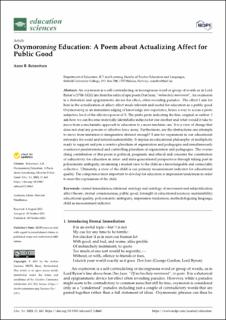| dc.contributor.author | Reinertsen, Anne B. | |
| dc.date.accessioned | 2022-01-24T07:39:21Z | |
| dc.date.available | 2022-01-24T07:39:21Z | |
| dc.date.created | 2021-12-03T14:53:15Z | |
| dc.date.issued | 2021 | |
| dc.identifier.citation | Education Sciences. 2021, 11 (11), Artikkel 663. | en_US |
| dc.identifier.issn | 2227-7102 | |
| dc.identifier.uri | https://hdl.handle.net/11250/2838812 | |
| dc.description.abstract | An oxymoron is a self-contradicting or incongruous word or group of words as in Lord Byron’s (1788–1824) line from his satirical epic poem Don Juan; “melancholy merriment”, An oxymoron is a rhetorical and epigrammatic device for effect, often revealing paradox. The effect I aim for here is the actualization of affect; affect made relevant and useful for education as a public good. Oxymoroning as an immediate edging of knowledge into experience, hence a way to access a proto subjective level of the affective power of X. The prefix proto indicating the first, original or earliest. I ask how we can become materially identifiable subjects for one another and what would it take to move from a mechanistic approach to education to a more machinic one. It is a view of change that does not steal my powers or affective force away. Furthermore, are the abstractions one attempts to move from imitation to imagination abstract enough? I aim for expansions in our educational rationales for social and natural sustainability. It implies an educational philosophy of multiplicity ready to support and join a creative pluralism of organization and pedagogies and simultaneously counteract predetermined and controlling pluralism of organization and pedagogies. The overarching contribution of this poem is political, pragmatic and ethical and concerns the constitution of subjectivity for education in inter- and intra-generational perspectives through taking part in polysemantic ambiguity, envisioning a modest view to the child as a knowledgeable and connectable collective. Ultimately, a view of the child is our primary measurement indicator for educational quality. The competence most important to develop for educators is impression tenderness in order to meet the expressions of the child. | en_US |
| dc.language.iso | eng | en_US |
| dc.publisher | MDPI | en_US |
| dc.rights | Navngivelse 4.0 Internasjonal | * |
| dc.rights.uri | http://creativecommons.org/licenses/by/4.0/deed.no | * |
| dc.subject | eternal immediation | en_US |
| dc.subject | relational ontology | en_US |
| dc.subject | ontology of movement and subjectification | en_US |
| dc.subject | affect theory | en_US |
| dc.subject | eternal consciousness | en_US |
| dc.subject | public good | en_US |
| dc.subject | foresight in educational sciences | en_US |
| dc.subject | sustainability | en_US |
| dc.subject | educational quality | en_US |
| dc.subject | polysemantic ambiguity | en_US |
| dc.subject | impression tenderness | en_US |
| dc.subject | methodologizing language | en_US |
| dc.subject | child as measurement indicator | en_US |
| dc.title | Oxymoroning education: A poem about actualizing affect for public good | en_US |
| dc.type | Peer reviewed | en_US |
| dc.type | Journal article | en_US |
| dc.description.version | publishedVersion | en_US |
| dc.rights.holder | © 2021 by the author. | en_US |
| dc.subject.nsi | VDP::Samfunnsvitenskap: 200::Pedagogiske fag: 280 | en_US |
| dc.source.volume | 11 | en_US |
| dc.source.journal | Education Sciences | en_US |
| dc.source.issue | 11 | en_US |
| dc.identifier.doi | 10.3390/educsci11110663 | |
| dc.identifier.cristin | 1964494 | |
| dc.source.articlenumber | 663 | en_US |
| cristin.ispublished | true | |
| cristin.fulltext | original | |
| cristin.qualitycode | 1 | |

